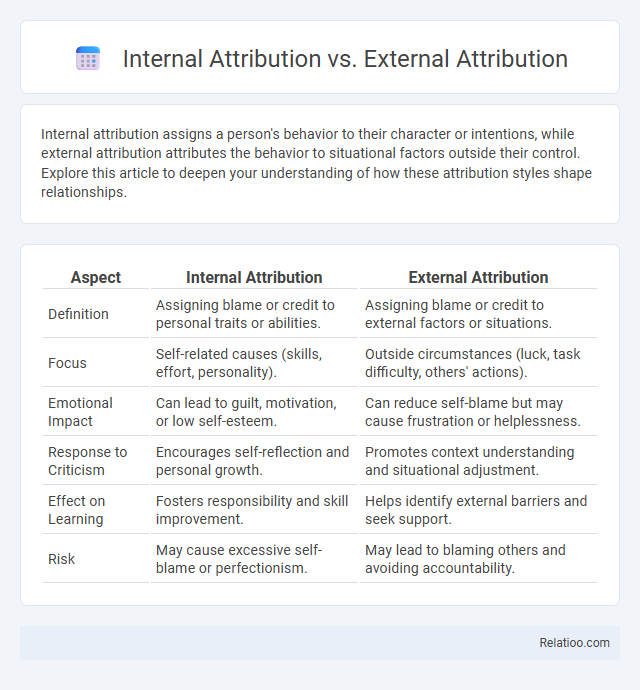Internal attribution assigns a person's behavior to their character or intentions, while external attribution attributes the behavior to situational factors outside their control. Explore this article to deepen your understanding of how these attribution styles shape relationships.
Table of Comparison
| Aspect | Internal Attribution | External Attribution |
|---|---|---|
| Definition | Assigning blame or credit to personal traits or abilities. | Assigning blame or credit to external factors or situations. |
| Focus | Self-related causes (skills, effort, personality). | Outside circumstances (luck, task difficulty, others' actions). |
| Emotional Impact | Can lead to guilt, motivation, or low self-esteem. | Can reduce self-blame but may cause frustration or helplessness. |
| Response to Criticism | Encourages self-reflection and personal growth. | Promotes context understanding and situational adjustment. |
| Effect on Learning | Fosters responsibility and skill improvement. | Helps identify external barriers and seek support. |
| Risk | May cause excessive self-blame or perfectionism. | May lead to blaming others and avoiding accountability. |
Introduction to Attribution Theory
Attribution theory explores how individuals infer the causes of behavior by categorizing them into internal attribution, which assigns behavior to personal traits or intentions, and external attribution, which attributes behavior to situational factors or environmental influences. Understanding these distinctions helps explain how people interpret actions and make sense of social interactions, influencing judgments and decision-making processes. The theory is foundational in psychology for analyzing the underlying motives behind observable behavior and predicting future responses.
Defining Internal Attribution
Internal attribution refers to explaining a person's behavior based on their own traits, abilities, or feelings rather than external factors. This concept contrasts with external attribution, which assigns behavior causes to outside influences such as the environment or other people. Understanding internal attribution helps you assess whether outcomes result from personal effort or inherent characteristics.
Defining External Attribution
External attribution attributes a person's behavior or event outcomes to situational factors beyond their control, such as environmental influences, social pressure, or luck. Unlike internal attribution, which assigns causes to personal traits or intentions, external attribution emphasizes context and external circumstances impacting behavior. Understanding external attribution helps clarify how external forces shape individuals' actions and decision-making processes.
Key Differences Between Internal and External Attribution
Internal attribution explains behavior by attributing it to personal traits, abilities, or feelings, emphasizing factors within the individual. External attribution assigns behavior to situational influences, such as environmental pressures or social context, highlighting factors outside the individual. The key difference between internal and external attribution lies in whether the cause of behavior is perceived as originating from the person or from external circumstances.
Common Examples of Internal Attribution
Internal attribution refers to attributing an individual's behavior to personal traits, abilities, or feelings, such as assuming a student's poor test performance is due to lack of effort or intelligence. Common examples include perceiving a colleague's success as a result of their hard work and dedication, or blaming a driver's anger on their aggressive personality. This contrasts with external attribution, which explains behavior based on situational factors, like attributing a missed deadline to unexpected technical issues.
Common Examples of External Attribution
External attribution involves explaining behavior by situating causes outside the person, such as situational factors, environmental influences, or social pressure. Common examples include attributing a student's poor exam performance to difficult test questions or a teammate's failure to a lack of adequate training or resources. You can better understand behaviors by distinguishing between internal factors, like personality traits, and external factors, which often clarify the context behind actions.
The Role of Attribution in Everyday Life
Attribution plays a crucial role in everyday life by helping individuals understand the causes of behavior and events. Internal attribution assigns responsibility to personal traits or intentions, while external attribution credits situational factors. Recognizing these distinctions aids in interpreting social interactions, managing relationships, and influencing decision-making processes.
Psychological Impact of Attribution Styles
Internal attribution attributes success or failure to personal factors such as effort or ability, often enhancing self-esteem and motivation but risking self-blame in failure. External attribution assigns outcomes to situational or environmental factors, which can reduce personal guilt but may diminish a sense of control and agency. Understanding these attribution styles critically influences psychological resilience, emotional well-being, and how individuals respond to challenges and setbacks.
Factors Influencing Attribution Choices
Attribution involves assigning causes to behaviors or events, influenced by internal factors like personality traits and intentions, and external factors such as situational pressures and environmental conditions. Internal attribution emphasizes personal responsibility, often linked to stable traits, while external attribution considers temporary external circumstances affecting behavior. Cognitive biases, cultural background, and past experiences significantly impact whether individuals favor internal or external explanations in their attribution choices.
Strategies to Balance Internal and External Attribution
Balancing internal and external attribution involves recognizing when outcomes result from your own skills or decisions versus external factors beyond your control. Strategies such as reflective self-assessment and seeking objective feedback can help you accurately differentiate between personal accountability and situational influences. Developing this balance improves decision-making, enhances emotional resilience, and guides more effective responses to successes and setbacks.

Infographic: Internal Attribution vs External Attribution
 relatioo.com
relatioo.com